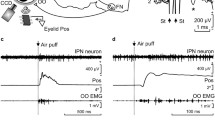Summary
Several lines of evidence suggest that the cerebellum is involved in classical conditioning of the eyeblink response. For instance, lesions to the interpositus nucleus abolish both learning and retention of conditioned responses. There is strong disagreement about the precise nature of the cerebellar involvement, however. Although many now believe that it is the site of learning, is has also been argued that the cerebellum is merely necessary for the normal performance of conditioned responses. In order to clarify the role of the cerebellum in conditioning, electrophysiological techniques were applied to decerebrate cats and ferrets, which can acquire normal conditioned responses. Four small discrete areas of the cerebellar cortex have been identified which seem to control the orbicularis oculi muscle. Electrical stimulation of these areas, which inhibits neurones in the interpositus nucleus, completely suppresses a conditioned response but has only a weak effect on the unconditioned response. Recordings from Purkinje cells in one of these areas show firing patterns which are consistent with their being involved in the learning of the conditioned response. In combination with results from other groups, these findings provide strong support for the cerebellar learning hypothesis.
Access this chapter
Tax calculation will be finalised at checkout
Purchases are for personal use only
Preview
Unable to display preview. Download preview PDF.
Similar content being viewed by others
References
Berthier, N.E. and Moore, J.W. (1986). Cerebellar Purkinje cell activity related to the classically conditioned nictitating membrane response. Experimental Brain Research 63, 341–350.
Ekerot, C.-F., Garwicz, M. and Schouenborg, J. (1991). Topography and nociceptive receptive fields of climbing fibres projecting to the cerebellar anterior lobe in the cat. Journal of Physiology 441, 257–274.
Gormezano, I. and Moore, J.W. (1976). Classical conditioning. In Learning: Processes, ed. Marx, M.H., Macmillan, New York.
Hesslow, G. (1994a). Correspondence between climbing fibre input and motor output in eyeblink related areas in cat cerebellar cortex. Journal of Physiology 476, 229–244.
Hesslow, G. (1994b). Inhibition of classically conditioned eyeblink responses by stimulation of the cerebellar cortex in the cat. Journal of Physiology 476, 245–256.
Hesslow, G., Hardiman, M. and Yeo, C.H. (1990). Cerebellar lesions abolish eyeblink conditioning in the decerebrate rabbit. European Journal of Neuroscience Suppl. 3: 301.
Hesslow, G. and Ivarsson, M. (1994). Suppression of cerebellar Purkinje cells during conditioned responses in ferrets. Neuroreport 5, 649–652.
Ito, M. (1984). The Cerebellum and Neuronal Control. Raven Press, New York.
Ivarsson, M. and Hesslow, G. (1993). Bilateral control of the orbicularis oculi muscle from one cerebellar hemisphere in the ferret. Neuroreport 4, 1127–1130.
Kelly, T.M., Zuo, C.-C. and Bloedel, J.R. (1990). Classical conditioning of the eyeblink reflex in the decerebrate-decerebellate rabbit. Behavioural Brain Research 38, 7–18.
Krupa D.J., Thompson, J.K., Thompson, R.F. (1993). Localization of a Memory Trace in the Mammalian Brain. Science 260, 989–991.
McCormick, D.A. and Thompson, R.F. (1984). Cerebellum: essential involvement in the classically conditioned eyelid response. Science 223, 296–299.
Nordholm, A.F., Lavond, D.G., Thompson, R.F. (1991). Are eyeblink responses to tone in the decerebrate, decerebellate rabbit conditioned responses? Behavioural Brain Research 44, 27–34.
Norman, R.J., Villablanca, J.R., Brown, K.A., Schwafel, J.A. AND Buchwald, J.S. (1974). Classical eyeblink conditioning in the bilaterally hemispherectomized cat. Experimental Neurology 44, 363–380.
Oakley, D.A. and Russell, I.S. (1972). Neocortical lesions and Pavlovian conditioning in the rabbit. Physiology and Behaviour 8, 915–926.
Oscarsson, O. (1980). Functional organization of olivary projection to the cerebellar anterior lobe. In The Inferior Olivary Nucleus: Anatomy and Physiology, ed. Courville, J., de Montigny, C. and Lamarre, Y., pp 279–289. Raven Press, New York.
Schmaltz, L.W. and Theios, J. (1972). Acquisition and extinction of a classically conditioned response in hippocampectomized rabbits (Oryctolagus cuniculus). Journal of Comparative and Physiological Psychology 79, 328–333.
Welsh, J.P. and Harvey, J.A. (1989). Cerebellar lesions and the nictitating membrane reflex: performance deficits of the conditioned and unconditioned response. Journal of Neuroscience 9, 299–311.
Yeo, C.H., Hardiman, M.J. and Glickstein, M. (1985a). Classical conditioning of the nictitating membrane response of the rabbit. I. Lesions of the cerebellar nuclei. Experimental Brain Research 60, 87–98.
Yeo, C.H., Hardiman, M.J. and Glickstein, M. (1985b). Classical conditioning of the nictitating membrane response of the rabbit. II. Lesions of the cerebellar cortex. Experimental Brain Research 60, 99–113.
Yeo, C.H., Hardiman, M.J. and Glickstein, M. (1986). Classical conditioning of the nictitating membrane response of the rabbit. IV. Lesions of the inferior olive. Experimental Brain Research 63, 81–92.
Author information
Authors and Affiliations
Editor information
Editors and Affiliations
Rights and permissions
Copyright information
© 1995 Springer Science+Business Media New York
About this chapter
Cite this chapter
Hesslow, G. (1995). Classical Conditioning of Eyeblink in Decerebrate Cats and Ferrets. In: Ferrell, W.R., Proske, U. (eds) Neural Control of Movement. Springer, Boston, MA. https://doi.org/10.1007/978-1-4615-1985-0_16
Download citation
DOI: https://doi.org/10.1007/978-1-4615-1985-0_16
Publisher Name: Springer, Boston, MA
Print ISBN: 978-1-4613-5818-3
Online ISBN: 978-1-4615-1985-0
eBook Packages: Springer Book Archive




